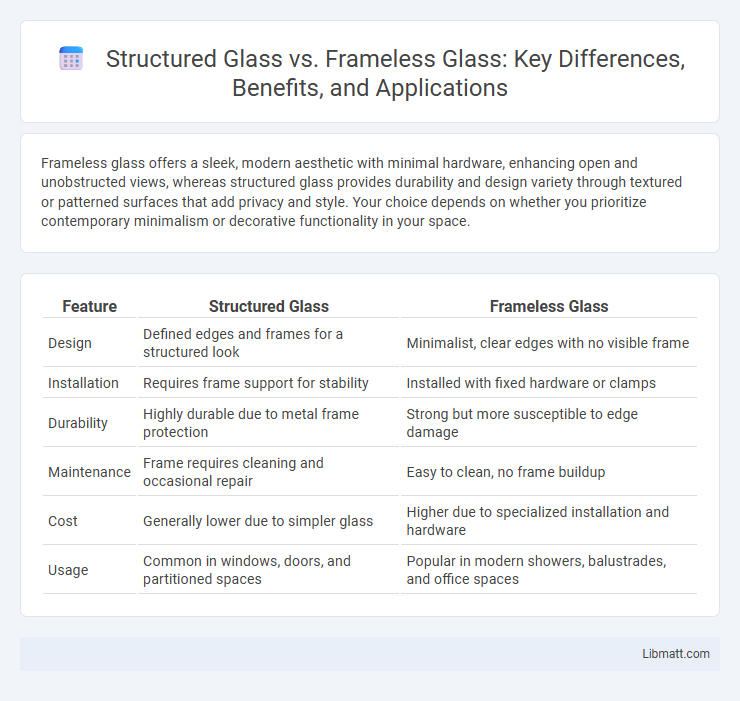Frameless glass offers a sleek, modern aesthetic with minimal hardware, enhancing open and unobstructed views, whereas structured glass provides durability and design variety through textured or patterned surfaces that add privacy and style. Your choice depends on whether you prioritize contemporary minimalism or decorative functionality in your space.
Table of Comparison
| Feature | Structured Glass | Frameless Glass |
|---|---|---|
| Design | Defined edges and frames for a structured look | Minimalist, clear edges with no visible frame |
| Installation | Requires frame support for stability | Installed with fixed hardware or clamps |
| Durability | Highly durable due to metal frame protection | Strong but more susceptible to edge damage |
| Maintenance | Frame requires cleaning and occasional repair | Easy to clean, no frame buildup |
| Cost | Generally lower due to simpler glass | Higher due to specialized installation and hardware |
| Usage | Common in windows, doors, and partitioned spaces | Popular in modern showers, balustrades, and office spaces |
Introduction to Structured and Frameless Glass
Structured glass features textured or patterned surfaces that provide privacy while allowing light transmission, commonly used in office partitions and decorative applications. Frameless glass consists of smooth, clear panels installed without visible frames, offering a minimalist and sleek appearance favored in modern architecture and shower enclosures. Both types utilize tempered or laminated safety glass to ensure durability and compliance with building codes.
Key Differences Between Structured and Frameless Glass
Structured glass features distinct patterns or textures that provide privacy and diffuse light, commonly used in decorative or functional applications, while frameless glass offers a sleek, minimalist look with uninterrupted transparency, often favored in modern architectural designs. Structured glass requires frames or supports to hold its uniquely shaped panels securely, whereas frameless glass relies on advanced mounting systems like clamps or channels to maintain stability without visible framing. The choice affects aesthetics, installation complexity, and maintenance, with structured glass prioritizing privacy and durability, and frameless glass emphasizing openness and seamless integration.
Aesthetic Impact: Structured vs Frameless Glass
Structured glass features patterned or textured surfaces that diffuse light and add visual interest, creating a dynamic aesthetic with privacy benefits. Frameless glass offers a sleek, minimalist look that maximizes transparency and openness, emphasizing uninterrupted views and modern elegance. Choosing between structured and frameless glass depends on whether the design prioritizes decorative texture or seamless clarity.
Structural Integrity and Durability
Structured glass offers enhanced structural integrity through its layered composition and reinforced frameworks, providing superior resistance to impact and environmental stress. Frameless glass relies on high-quality tempered or laminated glass for durability but may lack the additional support found in structured systems, increasing vulnerability to flexing and damage under load. Choosing structured glass ensures long-term stability and robustness in architectural applications where strength and safety are critical.
Installation Process Comparison
Structured glass installation involves securing pre-framed panels, requiring precise alignment and anchoring to existing frames, which can extend the setup time. Frameless glass installation demands expert handling with specialized fittings like clamps or channels to support the weight without visible frames, often resulting in a more complex and labor-intensive process. Your choice should consider the installation expertise available and the environment to ensure safety and aesthetic appeal.
Cost Analysis: Structured Versus Frameless
Structured glass typically incurs higher installation and maintenance costs due to its heavier framework and custom design requirements, whereas frameless glass offers a more streamlined installation with lower labor expenses. Frameless glass systems generally have higher initial material costs but reduce long-term maintenance expenses due to fewer metal components prone to corrosion. Cost analysis between the two depends on project scale, desired aesthetics, and durability needs, with structured glass suited for more robust applications and frameless glass preferred for minimalist, modern designs.
Maintenance and Cleaning Considerations
Structured glass typically requires more detailed cleaning efforts due to its textured surface that can trap dirt and grime, making maintenance slightly more labor-intensive. Frameless glass tends to be easier to maintain because its smooth surface allows for quick wiping without obstruction, reducing the accumulation of soap scum and water spots. When considering durability, Your choice may impact cleaning frequency and product use, with frameless glass benefiting from regular squeegeeing to maintain clarity and structured glass needing specialized cleaning solutions to prevent residue buildup.
Safety Features and Building Codes
Structured glass offers enhanced safety features with laminated or tempered options that meet stringent building codes for impact resistance and fire protection. Frameless glass, while aesthetically minimalistic, often requires thicker panes and specialized hardware to comply with safety regulations and prevent breakage or injury. Both glass types must adhere to local building codes like ASTM standards and International Building Code (IBC) requirements, ensuring proper load-bearing capacity and safety in architectural applications.
Best Applications for Each Glass Type
Structured glass is best suited for applications requiring privacy and decorative enhancement, such as office partitions, shower enclosures, and interior doors, where its textured surface diffuses light while obscuring visibility. Frameless glass is ideal for modern, minimalist aesthetics in spaces like glass balustrades, shower doors, and storefronts, offering unobstructed views and a sleek, seamless look. Your choice depends on whether you prioritize privacy and design texture or transparency and minimalism in your architectural or interior project.
Choosing the Right Glass for Your Project
Structured glass offers enhanced privacy and texture options, making it ideal for spaces needing both design and functionality, while frameless glass provides a sleek, minimalist look that maximizes natural light and openness. Selecting the right glass depends on your project's needs for privacy, maintenance, and aesthetic appeal, with structured glass excelling in decorative and obscured views, and frameless glass perfect for seamless transparency. Material durability, installation complexity, and safety ratings also influence the choice, ensuring the selected glass aligns with both practical requirements and architectural goals.
structured glass vs frameless glass Infographic

 libmatt.com
libmatt.com